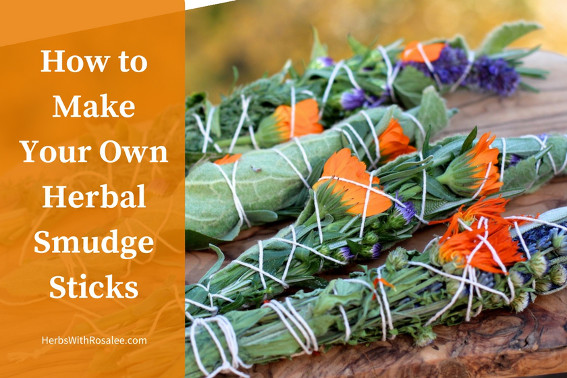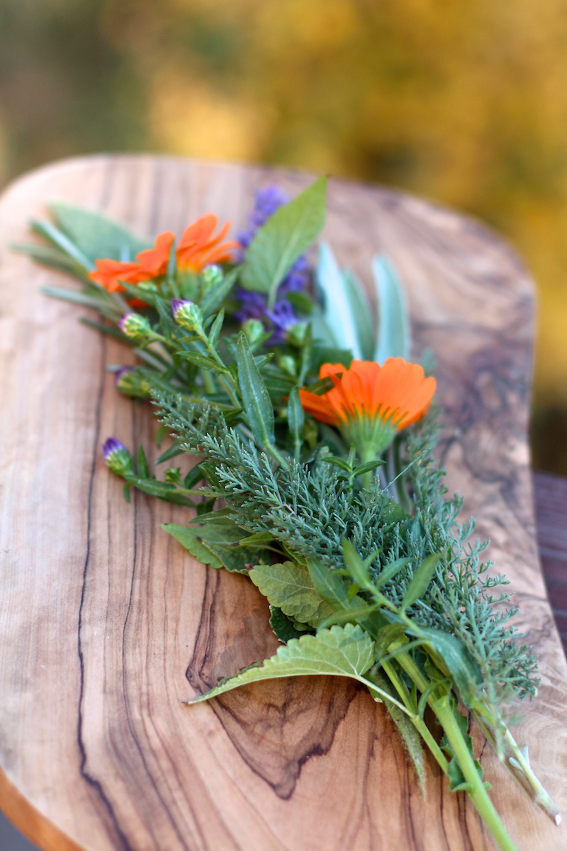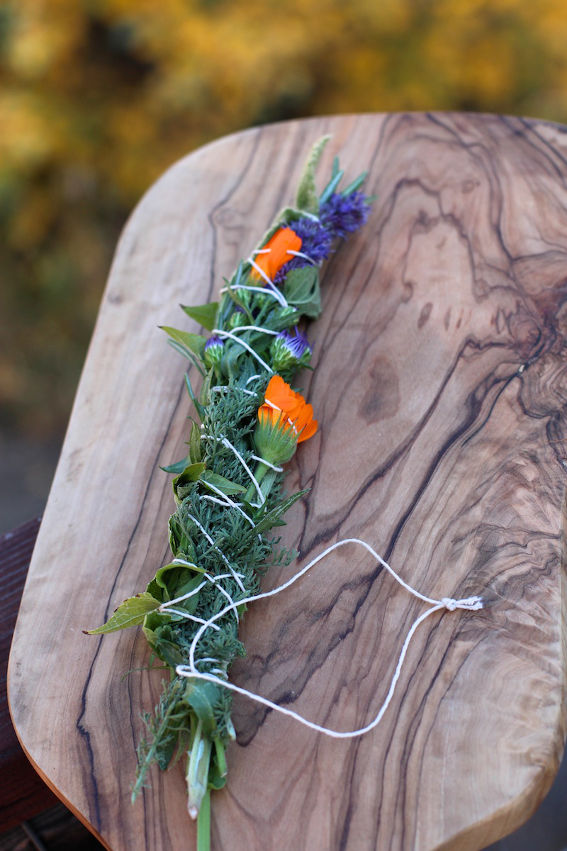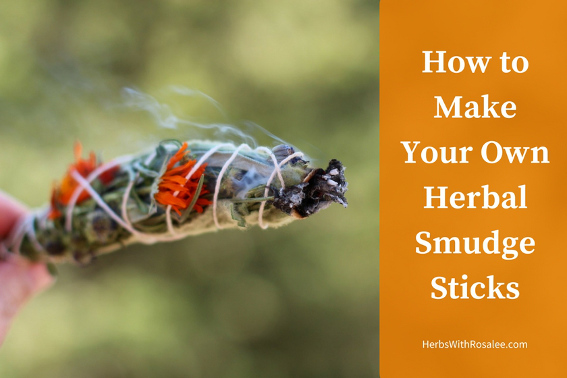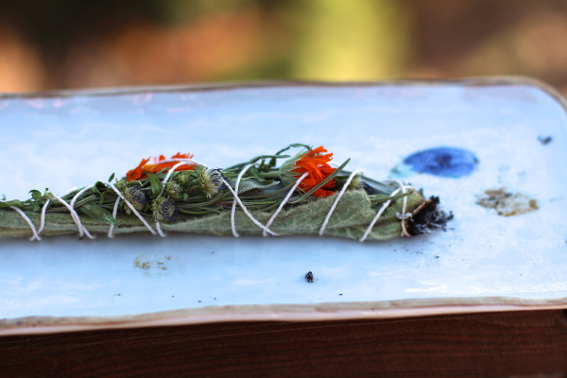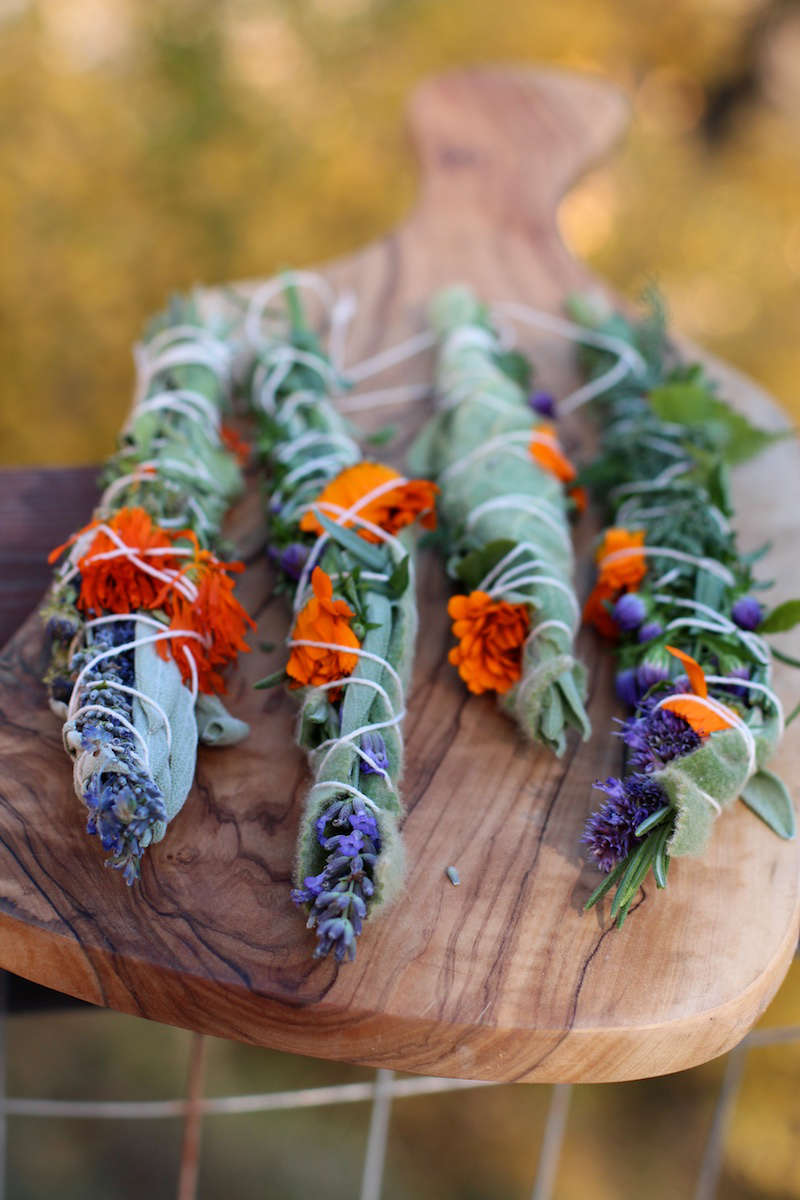Get weekly tips, recipes, and my Herbal Jumpstart e-course! Sign up for free today.

Herbal Smudge Sticks
Share this! |
|
Earlier this year my friend Larken Bunce gifted me with an herbal smudge stick. I was getting ready to leave the International Herb Symposium when she walked up and pulled out her beautiful collection of sticks and said I could pick one out. She told me that she harvested the herbs from her garden in the fall when things were about to die back.
What a beautiful gift! Handmade from herbs in her garden! I thought of her every time I burnt it.
I admit I’d seen articles about making your own herbal smudge sticks before, but it was Larken’s beautiful gift that inspired me to make my own.
What Are Herbal Smudge Sticks?
Herbal smudge sticks are dried bundled herbs that are lit and then left to smolder. The smoke from smudge sticks are used ceremonially, medicinally, or simply as an air freshener.
Sage smudge sticks, made from white sage (Saliva apiana), are the most popular smudge sticks and they are readily found commercially. However, in recent years many people have been questioning this use. Some say that using a sacred plant native to a small area is not sustainable. Others question the ethics of widespread use of a sacred plant.
Creating your own herbal smudge sticks from plants that grow near you is both sustainable and, if harvested appropriately, ethically sound. It’s also a lot more meaningful!
How to Make Herbal Smudge Sticks
Many different herbs can be used in a herbal smudge stick. Some may add aromatic qualities while others, like mullein, may offer support for the lungs. As you create your own traditions around burning your smudge sticks you may uncover your own meanings and virtues of different herbs.
Here’s the herbs that I used in my own sticks.
- Lavender (Lavandula angustifolia)
- Mullein (Verbascum thapsus)
- Yarrow (Achillea millefolium)
- New England Aster (Symphyotrichum novae-angliae)
- Calendula (Calendula officinalis)
- Sage (Salvia officinalis)
- Thyme (Thymus vulgaris)
- Rosemary (Rosmarinus officinale)
- Anise Hyssop (Agastache foeniculum)
- Big Sagebrush (Artemisia tridentata)
Larken shared with me that she also uses Mugwort (Artemisia vulgaris) and Hyssop (Hyssopus officinalis).
This is not an exhaustive list of herbs that can be used, but it will hopefully give you a good place to start.
Making your own herbal smudge sticks offers an opportunity for intention, meditation and reflection.
After harvesting your herbs with care, lay them out in front of you and gather them into small bundles. I loved how Larken had very different smudge sticks made with many different herbs. My own tended to be very similar to each other.
In addition to the herbs you’ll need some string to tie everything together. I used organic cotton kitchen string. You can eyeball how long to cut the string or leave it attached to the string ball.
Gather your small bundle at the base and using a cotton thread tie a knot tightly at the base. Leave a short end of the string at least three inches long. Using the other long thread weave the string up the bundle, securing everything together. Wrap this as tightly as possible as the herbs will shrink as they dry. (I know I’ll be wrapping mine even tighter next time.)
At the top of the bundle, wrap the string around and continue back down again. If desired you can do this one more time to really secure the bundle.
At the base tie off the string. Cut the long string to match the other at the base. Tie a little loop at the end that you can then use to hang the bundle as it dries. You can also place it on a screen. In either case you want their to be good air circulation to aid the drying process.
I hung mine to dry for about a month. I live in a very dry climate and did not have any issues with mold. Your climate may pose different challenges.
How to Use Herbal Smudge Sticks
Herbalists, healers, Native Americans, the spiritually devoted, religious leaders and people all over the world burn herbs and resins as part of their cultural and religious traditions. If burning herbs is not a tradition you grew up with, you have the opportunity to create intention and meaning specific to your life. As with all things with deep meaning this will develop over time.
To light your stick, use a match or lighter to light the end of the stick. Let it catch fire then lightly wave out or blow out the flames, leaving the stick to smolder.
Once you are done with the stick, place it in a fire proof container like a pottery bowl or plate. You may also want to stamp it out to discourage it from burning further. Avoid leaving a burning smudge stick unattended. Also do not use water to exstinguish the burning as this will make it harder to burn again.
Considerations
It’s extremely important that you only burn plants that are known to be safe.
Idiosyncratic reactions are always possible. When burning plants that are known to be safe but new to you, do so outdoors and cautiously smell the air rather than take a big gulp of straight smoke.
Inhaling too much smoke, even from beautiful herbal smudge sticks, is not healthy for your lungs.
Be sure to use a cotton string, avoid anything plastic or otherwise synthetic as you will be burning and breathing this too.

Rosalee is an herbalist and author of the bestselling book Alchemy of Herbs: Transform Everyday Ingredients Into Foods & Remedies That Healand co-author of the bestselling book Wild Remedies: How to Forage Healing Foods and Craft Your Own Herbal Medicine. She's a registered herbalist with the American Herbalist Guild and has taught thousands of students through her online courses. Read about how Rosalee went from having a terminal illness to being a bestselling author in her full story here.
